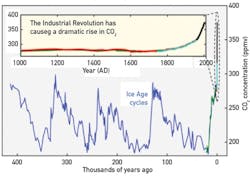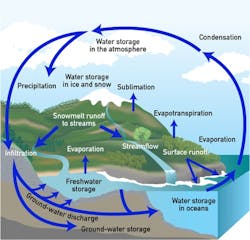N.Muthukumar
[email protected]
A: The valve failure position represents where the valve would move on the loss of the control signal. A valve that fails open is a reverse-acting valve. Coolant valves are normally reverse-acting, and heating valves are normally direct-acting; consequently, most temperature controllers are reverse-acting. In fact, most controllers are reverse-acting.
Greg Shinskey
[email protected]
Q: In one of your articles you discussed the gains, time contants, modeling and controls of non-industrial processes. Are the measurement devices and control models that were developed for industrial applications useful to reliably determine the trends of global processes? Is the knowledge gained in controlling industrial processes useful in modeling global ones, and predicting the future values of the variables involved?
H. Crowney
[email protected]
A: Yes, a process is a process, no matter if it's as simple as a heat exchanger or as complex as the weather, the economy or human evolution. The only difference is that global processes tend to have high inertia, require envelope control, and their manipulated variables are not control valves, but such complex variables as human behavior. Therefore, if we want to keep such processes on setpoint (inside a safe envelope), we have to influence (manipulate) human behavior, and that's not as easy as throttling a valve.
Probably the most obvious global process that is out of control today—like the level in a tank where inflow exceeds outflow—is carbon accumulation in the atmosphere. The contribution the process control profession can make to close the debate about the dangerous consequences of this accumulation is first to find a measurement that is undeniably unique, and then reliably determine the time constants, inertia, gain, etc., of this carbon-temperature loop, and predict where the uncontrolled variable (global temperature) will get to if the process stays in the "open loop." Similarly, process control modeling can determine how this loop can be "closed," and after that, how long it will take to reach a particular steady state.
We know the carbon dioxide concentration of the atmosphere today, and we have measured what it was during the past half million years. We know that, in spite of ice ages and asteroid impacts, etc., it has never exceeded 280 ppm. We also know that today it is 390 ppm (Figure 1), and that at the present rate of rise (open loop), it will reach 510 ppm by 2050.
Figure 1. Carbon concentration during the last 500,000 years.
Yet this knowledge is not enough to prove that CO2 emission is the cause of global warming, nor is it enough to calculate how much time we have before the consequences become disastrous. Why not? Because the deniers can still argue that something else is the cause. Yet it is in everybody's interest to close this debate and process control modeling can do that! How?
Well, it is not enought to measure the rising temperature of the oceans or the melting of polar ice. We need a variable that is "CO2-specific" and is affected by nothing else! It is not enough to know that millions of years ago the Permian volcanic eruption caused the extinction of 95% of the planet's species because we do not know for sure if that extinction was caused by catastrophic amounts of carbon which were sent into the air. It is not enough to know that we humans are every bit as good (actually better) at putting carbon dioxide into the atmosphere than are volcanoes. What we need is a reliable "CO2-specific" measurement and an undeniable method to calculate the gains and time constants of this loop. In my view, that reliable variable is the pH and the salt content of the oceans.
During the past century, the pH of the oceans dropped by about 0.3 pH, and the rate of this acidification is rising. Nothing else can cause that but CO2. Based on pH, we (the process control people) can accurately predict where this "open loop" process will take us in a year, a decade or in a century. We can also calculate the size of the "manipulation" needed to reverse this trend and reach a steady state which we can live with.
We can also measure the oceans' salt content at locations both near the Equator, where increased heat input increases evaporation and, therefore, the ocean surface becomes saltier, and to the north, where increased precipitation causes it to drop (Figure 2). The dynamics of this "water circulation loop" and the rate at which the salt concentration difference is rising is another undeniable indicator of the rising heat input of the planet.
Figure 2. Near the Equator (on the right) the hot water evaporates and travels to the north (on the left) where it cools and condenses.
Naturally, in addition to the increased rate of water circulation, the same cycle is taking place below the oceans' surface, because the melting ice near the poles further reduces the salt content of the ocean, which slows the ocean currents and increases the formation of tornados and hurricanes, as I explained in detail in my articles in the March and May issues of Control in 2006 (March, Can Process Control Help Stabilize Global Warming?; May, Why Do We Have Global Warming?).
This increased circulation results in desertification (destruction of agriculture) at the evaporation end of the cycle and flooding at the other. The science of process control is important because by measuring the dynamics of this "open loop," we can tell where it will take the planet and when.
Now, as far as "closing the loop," we have to "throttle" its manipulated variable, which is human behavior! How do we do that? By education, explaining that there is a profession (process control) that can guide the smooth conversion of our lifestyle to be fueled by an inexhaustible, clean and free energy source, the Sun.
I could make the same argument for closing the loop on the relationship between the emission of radioactive substances and cancer, natural gas emission and allergy, the accumulation of endocrine disruptors from herbicides and obesity or the global destruction of the male hormones, etc., but I think the above example is enough to show that the science of process control is also applicable to non-industrial processes.
Bela Liptak
[email protected]
A: Why did we stop talking about the old term "degree days," which we used in ASHRAE to size heat pumps. The public gets only the record highs and lows, which are not related to energy. There is also no data on the global solar insolation. The reason why we have constant arguing over global warming is because we can't complete a simple energy balance on the earth or any other planet like Mars.
Reed Morton
[email protected]







